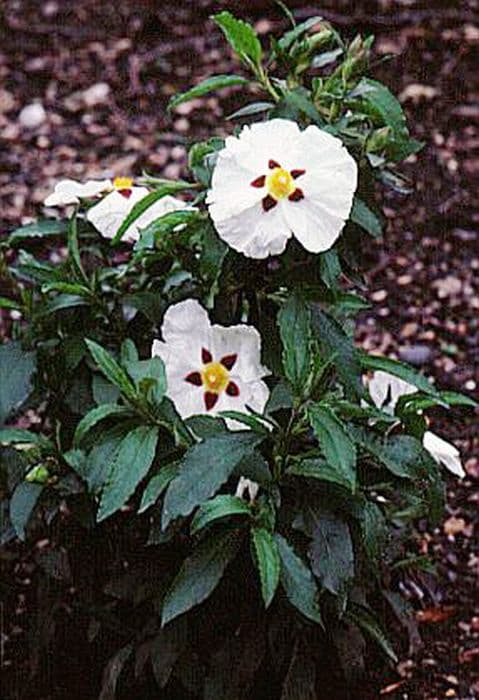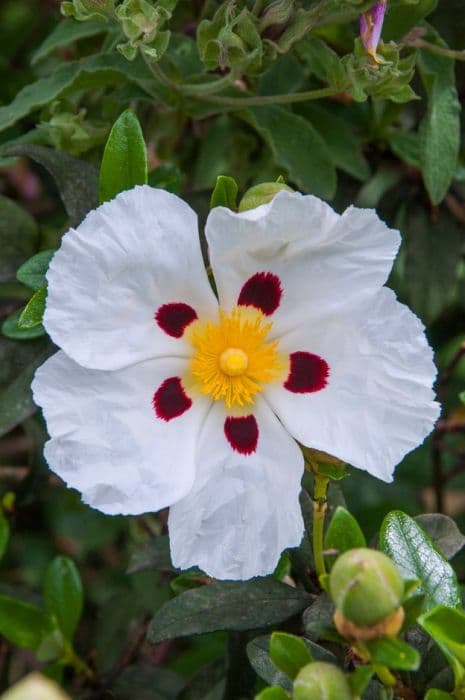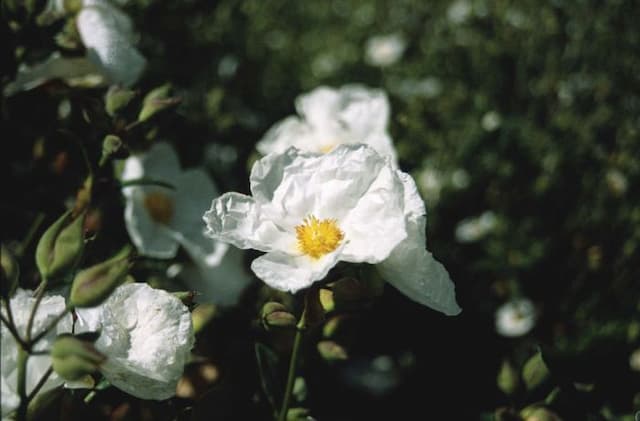Rock rose 'Gold Prize' Cistus × hybridus 'Gold Prize' (v)

ABOUT
'Gold Prize' is a dense, bushy, evergreen shrub with yellow leaves splashed green in the centre. White, saucer-shaped flowers with yellow centres open from red buds in summer
About this plant
 Names
NamesFamily
Cistaceae
Synonyms
Gold Prize Rockrose, Gold Prize Cistus
Common names
Cistus × hybridus 'Gold Prize' (v)
 Characteristics
CharacteristicsLife cycle
Perennials
Foliage type
Evergreen
Color of leaves
Green
Flower color
White
Height
3 feet (0.91 meters)
Spread
5 feet (1.52 meters)
Plant type
Shrub
Hardiness zones
8
Native area
Mediterranean
Benefits
 General Benefits
General Benefits- Landscape Aesthetics - The plant's attractive foliage and vibrant flowers enhance garden aesthetics.
- Drought Tolerance - Cistus × hybridus 'Gold Prize' (Rock Rose) is highly drought-resistant, requiring minimal watering once established.
- Low Maintenance - It requires very little upkeep regarding pruning and other care practices.
- Erosion Control - Its root system can help stabilize soil and prevent erosion on slopes.
- Wildlife Attraction - The flowers attract pollinators such as bees and butterflies, supporting local ecosystems.
- Adaptability - This plant can thrive in a variety of soil types, as long as they are well-draining.
- Evergreen Foliage - Provides year-round greenery and structure to the landscape.
- Heat Resistance - It stands up well to high temperatures, making it suitable for warm climates.
- Deer Resistance - Generally resistant to deer, preventing damage to the garden from wildlife.
 Medical Properties
Medical PropertiesThis plant is not used for medical purposes.
 Air-purifying Qualities
Air-purifying QualitiesThis plant is not specifically known for air purifying qualities.
 Other Uses
Other Uses- Cistus x hybridus 'Gold Prize', commonly known as Rockrose, can be used in the creation of natural dyes, as the foliage and flowers can produce different hues depending on the mordants used.
- In perfumery, Rockrose is used for its resinous scent as a fixative, especially in Mediterranean-styled fragrances reminiscent of the dry summer landscape where it thrives.
- The fibrous bark of the Rockrose can be utilized for making primitive ropes or strings in a survival context or for educational purposes related to historical textile production practices.
- Rockrose petals can be used in crafting potpourri mixes, contributing a subtle fragrance and adding to the visual diversity with their crinkled texture.
- The plant has the potential to be used as an eco-friendly ground stabilizer for slopes and banks to prevent soil erosion owing to its hardy and spreading nature.
- The thick and bushy nature of Rockrose makes it suitable for privacy hedging or wind breaks in coastal areas where it can withstand salty winds.
- Rose petals are sometimes used in culinary practices to decorate desserts or infuse sugars, and Rockrose petals could serve a similar, albeit more novel, decorative purpose.
- The sticky resin collected from Rockrose, known as labdanum, is traditionally used in making incense and could be crafted into homemade scents for those interested in artisanal incense production.
- Due to its aromatic foliage, dried Rockrose leaves can be incorporated into herbal sachets to naturally repel moths and possibly other insects in closets and drawers.
- Rockrose shrubs can be planted as part of fire-resistant landscaping, particularly in regions prone to wildfires, as they are considered to be relatively flame retardant compared to other vegetation.
Interesting Facts
 Feng Shui
Feng ShuiThe rockrose is not used in Feng Shui practice.
 Zodiac Sign Compitability
Zodiac Sign CompitabilityThe rockrose is not used in astrology practice.
 Plant Symbolism
Plant Symbolism- Resilience: The rockrose (Cistus × hybridus 'Gold Prize') is known for its ability to survive in poor soil conditions and drought, symbolizing the strength and resilience to endure and thrive in challenging situations.
- Healing: Historically, the resin or labdanum obtained from some Cistus species has been used for medicinal purposes, which associates the plant with healing and therapeutic properties.
- Beauty: With its attractive golden-foliage and white flowers, the rockrose symbolizes beauty and the appreciation of aesthetic qualities in nature.
- Renewal: As a plant that is capable of regenerating after fires, rockrose represents rebirth and the ability to start anew after adversity.
 Water
WaterRockrose 'Gold Prize' requires moderate watering, especially during its growing season in the spring and summer. It's best to water this plant thoroughly when the top inch of soil feels dry to the touch, which typically means providing approximately 1 gallon every week or two, depending on the climate and weather conditions. Over-watering can lead to root rot, so it is important to ensure good drainage. During the winter, reduce watering to every few weeks, allowing the soil to dry out more between waterings, as the plant enters a dormant period.
 Light
LightRockrose 'Gold Prize' thrives in full sunlight and should be placed in a spot where it can receive at least six hours of direct sunlight daily. It can tolerate some light shade, but flowering and foliage color are most vibrant when the plant is exposed to ample sunlight. Avoid deep shade locations, as they will negatively impact the plant's growth and flowering capabilities.
 Temperature
TemperatureRockrose 'Gold Prize' is suitable for a wide range of temperatures, comfortably growing in regions where the temperature remains between 20°F and 100°F. The ideal temperature range for this plant is between 60°F and 80°F, where it will flourish with appropriate care. However, it is frost hardy and can withstand brief periods of colder temperatures down to around 20°F without significant damage.
 Pruning
PruningPrune Rockrose 'Gold Prize' to maintain its shape and encourage bushier growth. Light pruning can be done in late winter or early spring before new growth begins. It's also beneficial to remove any dead or damaged wood at this time. Major pruning should occur every few years to keep the plant vigorous, but avoid cutting into old wood as it may not regenerate.
 Cleaning
CleaningNot needed
 Soil
SoilThe Rock Rose 'Gold Prize' thrives in well-draining soil with a pH range from neutral to slightly alkaline. A mix incorporating sandy or gritty material is ideal, ensuring good drainage to prevent root rot. Enrich the soil with organic matter to support growth.
 Repotting
RepottingRock Rose 'Gold Prize' should be repotted every two to three years to replenish the soil and give roots space to grow. They do not like to be disturbed too often, so ensure to repot only when necessary.
 Humidity & Misting
Humidity & MistingThe Rock Rose 'Gold Prize' prefers a low to moderate humidity environment. It is well-adapted to dry conditions and does not require high humidity to thrive.
 Suitable locations
Suitable locationsIndoor
Place in bright, indirect light and avoid overwatering.
Outdoor
Plant in full sun, well-drained soil, and shelter from harsh winds.
Hardiness zone
8-11 USDA
 Life cycle
Life cycleCistus × hybridus 'Gold Prize', commonly known as the Rock Rose 'Gold Prize', starts its life as a seed, which germinates in warm conditions after exposure to soil and moisture. The seedling stage soon follows, characterized by the emergence of primary leaves as it establishes a root system. The vegetative stage is next, where the plant exhibits rapid growth of stems and leaves and develops its trademark hairy, evergreen foliage. During the reproductive stage, typically in late spring to early summer, it produces showy yellow-centered, white flowers that attract pollinators. After pollination, it sets seed, which are then dispersed by various means, including wind and wildlife. Finally, as a perennial, the Rock Rose 'Gold Prize' enters a period of dormancy in winter, only to regrow from the same root system the following spring.
 Propogation
PropogationPropogation time
Spring-early summer
Cistus × hybridus 'Gold Prize', commonly known as Rock Rose, is typically propagated through semi-hardwood cuttings. This method is most successful when performed in late summer, allowing for enough time for the cuttings to establish roots before the onset of winter. To propagate Rock Rose using semi-hardwood cuttings, one would take cuttings of about 4 to 6 inches (10 to 15 centimeters) in length from the current year's growth. The leaves on the lower half of the cutting should be removed, and the base of the cutting should be dipped in rooting hormone to enhance root development. The treated cutting can then be planted in a well-draining rooting medium and kept in a humid environment until roots have formed, which usually takes several weeks. After rooting, the new plants can be gradually acclimatized to outdoor conditions before being planted out in their final location.









